


Vol. XXIX,
8 October, 2022
ON THE COVER
Our cover photo this month is a little different than usual. This month, as we meet at a gala dinner, we celebrate 100 continuous years of The Greater City Aquarium Society! Whether you’ve been a Greater City member for five months or 50 years, you are part of something unusual. I don’t imagine that our GCAS forbears who began this club a century ago thought much about such longevity, but here we are! Now the club and its continued longevity is in our hands. Will we continue to live long and prosper?
GREATER CITY AQUARIUM SOCIETY
Boa RD Me MB e R S
President Horst Gerber Vice-President Edward Vukich Treasurer Jules Birnbaum Assistant Treasurer Leonard Ramroop Corresponding Secretary Open President Emeritus Joseph Ferdenzi
Me M B e R S at La R G e
Pete D’Orio Al Grusell Jason Kerner Dan Radebaugh Marsha Radebaugh
Co M M i ttee Chai R S
Bowl Show Joseph F. Gurrado Breeder Award........................Harry Faustmann
Early Arrivals Al Grusell Membership Marsha Radebaugh N.E.C. Delegate Artie Mayer
Media Gilberto Soriano Technical Coordinator Jason Kerner
MODERN AQUARIUM
Editor in Chief Dan Radebaugh
Editors:
Alexander A. Priest Susan Priest Donna Sosna Sica Thomas Warns
Advertising Manager Robert Kolsky
In This Issue
From The Editor
G.C.A.S. 2022 Program Schedule
President’s Message
Our Generous Sponsors and Advertisers
Pictures From Our Last Meeting
Photos by Leonard Ramroop Memories Are Made of This
by Susan Priest September’s Caption Winner
Cartoon Caption Contest
by Denver Lettman
Friends Don’t Give Friends These (diseases) Plants
by Justin Warnock and Gary Lange Fishy Friendsʼ Photos
The Origin of the GCAS
MA Classics by Joseph Ferdenzi
Tales from the Tank
Name That Fish! by Dan McKercher
A History of the Greater City Aquarium Society
MA Classics by Joseph Ferdenzi
Bowl Show Winners
G.C.A.S. Member Discounts
Modern Aquarium Covers 2007
MA Classics
The Undergravel Reporter
Sounding Off
Fin Fun (Puzzle Page)
Beneath The Waves
2
3
4
5
6
7
9
10
11
14
15
18
19
23
24
26
27
28
Series III
No.
Programs....................................................Open Social
Copy
From the Editor
by Dan Radebaugh
Thisissue of Modern Aquarium really gets around! President Horst Gerber really brings home the bacon in his remarks. Following Lennie Ramroops’s “Pictures From Our Last Meeting,” Sue Priest makes a welcome appearance, hearkening back to former meeting venues and personalities that stand out from those times and places.
Be sure and have a shot at this month’s Cartoon Caption Contest! Doesn’t cost a thing to lose, and you might even win!
Our next full article in this issue is by a couple of authors whose names you may be familiar with: Justin Warnock and Gary Lange, who tell us how to deal with some nuisance plants. I’m sure you can think of a couple before even looking at the article!

This year marks the 100th anniversary of our club, and following our Fishy Friends Photos on page 14 is a piece by Joseph Ferdenzi, who tells us about “The Origin of the Greater City Aquarium Society.” How did this club happen? Joe will tell you!

After Dan McKercher tells us about the naming of some of our favorite fish (page 18), we turn again to Joe Ferdenzi for a really comprehensive history of our club. See “A History of the Greater City Aquarium Society” on page 19.
Following the Bowl Show awards on page 23 we look at the cover photos from the 2007 issues of Modern Aquarium. I think that most of you will recognize many of these fish, to say nothing of their photographers!
As usual, the issue closes with The Undergravel Reporter and the FIN FUN puzzle. Good luck! I hope to see many of you at our Banquet!
Modern Aquarium - Greater City A.S (NY)2 October 2022
The members of the Greater City Aquarium Society would like to thank the following for their generous support of our 100th Anniversary Celebration! AQUA HUT 264 MiDDLe CoUNtRY RoaD CoRaM, NY 11727 MONSTER AQUARIUM 131-08 40th RoaD FLUShiNG, NY 11354
GCAS Programs
submitted for consideration in Modern Aquarium (ISSN 2150-0940) must be received no later than the 10th day of the month prior to the month of publication. Please email submissions to gcas@earthlink.net, or fax to (347) 379-4984. Copyright 2022 by the Greater City Aquarium Society Inc., a not-for-profit New York State corporation. All rights reserved. Not-for-profit aquarium societies are hereby granted permission to reproduce articles and illustrations from this publication, unless the article indicates that the copyrights have been retained by the author, and provided reprints indicate source, and that two copies of the publication are sent to the Exchange Editor of this magazine (one copy if sent electronically). For online-only publications, copies may be sent via email to gcas@earthlink.net. Any other reproduction or commercial use of the material in this publication is prohibited without prior express written permission. The Greater City Aquarium Society meets every month except January and February. Members receive notice of meetings in the mail or by email. For more information, contact: Dan Radebaugh at (718) 458-8437, email to gcas@earthlink.net, or fax to (347) 379-4984. For more information about our club or to see previous issues of Modern Aquarium, you can also go to our Internet Home Page at http://www.greatercity.net, http://www. greatercity.org, or http://www.greatercity.com.
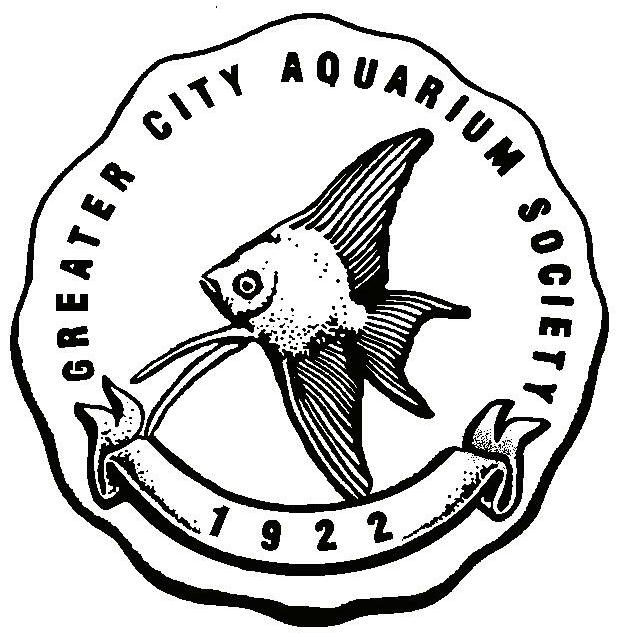
Modern Aquarium - Greater City A.S (NY) October 2022 3
2022 March 2 Scott Dowd Project Piaba April 6 Rosario LaCorte Images From A Lifetime of Fish Breeding May 4 Warren Feuer Shell Dwelling Cichlids June 1 Dr. Enea Parimbelli Voyage in Lake Tanganyika July 6 Joseph F. Gurrado Reef Keeping August 3 A Night at the Auction September 7 Andreas Tanke Plecos of the Rio Xingu October 7 Gala Buffet Dinner Douglaston Manor November 2 TBA TBD December 7 Mark Soberman Corydoras catfish Articles
President’s Message
by Horst Gerber
Withoutthe assistance, talent, inspiration and hardworking dedication of our Gala Committee tonight’s party might never have been planned, organized, or accomplished. Under Joe Ferdenzi’s guidance, Jules Birnbaum, Ed and Linda Vukich, Leonard Ramroop, and Marsha Radebaugh all worked tirelessly and devotedly for months on end developing the theme, searching for a venue, and filling in details. A big thank-you for all the details that our small group was able to pull together! And a special thanks to Linda Vukich, member by marriage, for lending her valuable event planning expertise. We are indebted to all of them for making Joe’s and our vision a reality. Whether proofreading text or advising on means, Joe Ferdenzi pushed tirelessly to have this party be special. And without the indispensable technical participation of Jason Kerner, this evening would not have been possible. Kudos also to my wife for her unending feedback and support.
We also must mention supporters such as Monster Aquarium, Zoo Med, and others whose support has been indispensable. Joe Ferdenzi put endless energy into having the best party a fish club could wish for! If Joe had stayed on as President he would by now have served for more than 30 years! With his tireless energy he is still the backbone of our club. That is at least my opinion.

Other major figures in our success have been Jules – the guardian of our finances and a regular contributor to Modern Aquarium, Harry Faustmann, Ed & Linda Vukich, Dan & Marsha Radebaugh. Sometimes it can be easy to forget how many things a fish club needs to come together to make an event really engaging.
If I’ve forgotten anyone please excuse me. My age is probably showing through. I’m not as sharp as I was say 40 years ago. We have the best support staff a club could wish for! See our masthead to find out who is doing what to help assure our continuing success. It’s great to see all of our wonderful members pulling together to keep this club not only surviving, but continuing to thrive after all this time together. You are the greatest!

4 October 2022 Modern Aquarium - Greater City A.S (NY)
Horst If you like history, and you like pets, then this is the place for you. Dedicated to the history of aquarium & pet keeping, The Museum of Aquarium & Pet History includes a huge depository of over 3,000 items all focused on the pet industry. From antique fish bowls, aquariums and cages, to foods, medications, books and advertising signs, we’ve got it all! To learn more about this amazing collection of historical pet artifacts, please visit our website: moaph.org https://moaph.org/
Advanced Marine Aquatics
Al’s Aquatic Services, Inc.

Amazonas Magazine
Aquarium Pharmaceuticals
Aquarium Technology Inc.
Aqueon
Brine Shrimp Direct
Carib Sea
Cobalt Aquatics
Coralife
Ecological Laboratories
Fishworld
Florida Aquatic Nurseries
Franklin Pet Center Inc
Fritz Aquatics
HBH Pet Products
High Quality Exotic Goldfish
Hydor USA
Jehmco
Jungle Bob Enterprises
Jungle Labs
Kent Marine
KHC Aquarium
Kissena Aquarium
Marineland
Microbe Lift
ModernAquarium.com
Monster Aquarium, Inc.
Nature’s Reef & Reptile
NorthFin Premium Fish Food
Ocean Nutrition America
Oceanic
Omega Sea
Pacific Aquarium, Inc.
Penn Plax
Pets Warehouse Pet Resources
Pisces Pro
Red Sea
Rena
Rolf C. Hagen
San Francisco Bay Brand
Seachem
Sera
Spectrum Brands
Your Fish Stuff.com
Zilla
Zoo Med Laboratories Inc.
Modern Aquarium - Greater City A.S (NY) October 2022 5
Pictures From Our Last Meeting
Photos by Leonard Ramroop
Another opening, another show for old pros Pete d’Orio and Artie Friedman.

Our members are ready for the program to begin...

There is always curiosity at the auction table.


Our president, Horst Gerber, waits for the right moment to begin.

Bill Amely looks like a person who has been here before...





6 October 2022 Modern Aquarium - Greater City A.S (NY)
Above: Bowl show winners John Buzzetti and Roger Inseti receiving their well-earned ribbons.
Jason Kerner getting his game face on for the evening.
Our speaker this evening, Andreas Tanke
“Memories Are Made Of This” *
by Sue Priest
Where to begin? The GCAS has been a very big part of my life for a long time, and memory after memory of these wonderful years keep floating to the surface of my mind.
I actually remember the first meeting that Al and I ever attended, so that seems like a good place to start. When we arrived at our first GCAS meeting the person in charge of membership wasn’t there, so we couldn’t sign up. If we wanted to join the club we had to come back!
I remember those long-ago Holiday Parties which we held in the “old” building. We each donated something to the feast. None of them could compare to the contributions that Anita Ferdenzi would send to our repast each year. Not many of you may remember that there were a few years when I was the membership chairlady. I especially remember when Elliot Oshins joined the club. He wanted to make sure I noticed that his last name was particularly appropriate for our group. Also, during my tenure we had 100 members for the first time.
Speakers! What can I say about them? We have had a cornucopia of speakers, a ‘who's who’ of the most knowledgeable aquarists on this planet. The volume of information that I have accumulated from them is beyond remembering. We had a few of these celebrity aquarists staying at our home on
occasion. I’m not much of a hostess, but we all got along fine.
I would like to add here that my favorite speakers over the years have been the ones that have come from our own membership. They always seemed to add something personal which made their offerings of information and experience all the more memorable.
I remember there was a short time when we held our meetings in the nearby VFW hall. The reason we were at the VFW was that the Botanical Garden was tearing down the older building and replacing it with the “new” building we use now. There were a few meetings when we brought our dog Joey with us. (Dogs are not allowed at the Botanical Garden.) Everyone enjoyed him, and he enjoyed the attention.
More importantly, it was during our time at the VFW that Dan and Marsha became members, and it didn’t take them very long before they made themselves indispensable!
The GCAS has put on a variety of fish shows at a variety of venues over the years of my membership. One thing I remember, and I hope I’m right about this, is that the very first GCAS fish show which Al and I attended was in the education building of the Botanical Garden. I don’t believe we were even members of the group yet, and we took first prize for our Aquarium Beautiful tank.
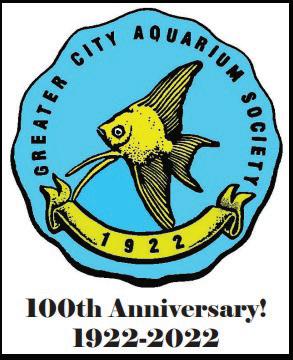
Modern Aquarium - Greater City A.S (NY) October 2022 7
Modern Aquarium - Greater City A.S. (NY) October 2022 17
There is nothing like a GCAS auction, of which I have attended more than I can count. There are always homebred fry, plants from someone’s backyard tank, live as well as dry foods, and a variety of equipment both new and used. In other words, something for everyone. Here is another aspect of the same topic. I can remember quite a few different auctioneers over the years. There are two which stand out in my mind. One of them could get you to bid on something you really didn’t want. The other one would raise the price so fast that you would say to yourself “Woops! I just overpaid for those corys.” I think it is best to let them both remain anonymous.

Modern Aquarium speaks for itself. Joe Ferdenzi has covered every detail of all three series so thoroughly over the years that I don’t think I have much to contribute. I can only add that for a long time getting my own copy of MA was my main reason for coming to a meeting. That is how highly I regarded it, and I still do.

The next time you are perusing your closet, take special notice of your GCAS T-shirts. How many of them do you have? Which one is your favorite? If you haven’t done so for awhile, give Jason Kerner a big “thank you” for all of his design work as well as for producing most of them. Which one is my favorite? All of them!
For as long as I can remember there has been a raffle at every meeting. Sharon Barnett used to buy $30 or more worth of raffle tickets. Every time she won something, which was often, she would give it to someone else. “Sue, would you like this mermaid figurine?” If she still had some raffle tickets when it was time for her to leave, she would hand them to the person standing next to her. Some of my memories are murky and incomplete, and others are crystal clear. I have tried to tell you about the highlights, but there are way too many to include in this article. Wet Leaves, the Ladies Issue, and Jello will have to wait for another day!
* The title of this article is also the title of a song written in 1955, and made famous by Dean Martin. (Ask Alexa to play it for you.)
Modern Aquarium - Greater City A.S (NY)8 October 2022
18 October 2022 Modern Aquarium - Greater City A.S. (NY)
September՚s Caption Winner: Tom Warns



Modern Aquarium - Greater City A.S (NY) October 2022 9
Finally a place to escape the pup-arazzi!
The Modern Aquarium Cartoon Caption Contest
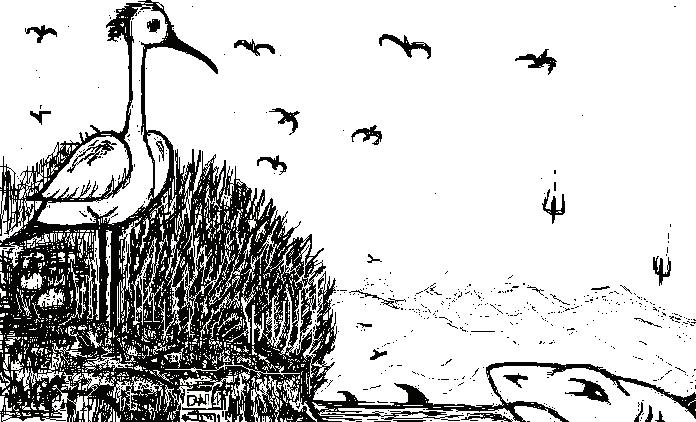
Modern Aquarium has featured cartoon contests before, and theyʼre back! You, the members of Greater City get to choose the caption! Just think of a good caption, then mail, email, or phone the Editor with your caption (phone:347-866-1107, fax: 877-299-0522, email: gcas@ earthlink.net. Your caption needs to reach the Editor by the third Wednesday of this month We'll also hand out copies of this page at the meeting, which you may turn in to Marsha or Dan before leaving. Winning captions will earn ten points in our Author Awards program, qualifying you for participation in our special ”Authors Only” raffle at our Holiday Party and Banquet. Put on your thinking caps!
Your Caption:
Your Name:
10 October 2022 Modern Aquarium - Greater City A.S (NY)
Friends Don’t Give Friends These (diseases) Plants!
by Justin Warnock and Gary Lange
Below is a conversation that evolved on the a local Missouri Aquarium Society Band forum page starting with an inquiry about one of the plants that were for sale, Phyllanthus fluitans, the “Red Root Floater.” It reminded us both of some other evil plants besides duckweed.
work, 3-5 days in a row. Lower the water a bit in the aquarium and then pull out every piece you see using a fine mesh net. Don’t lower it too much, as you don’t want it to get stuck in your rooted plants. Make sure to splash water up on the inside lip of the tank where duckweed hides to remove it all. Remove the tank cover and wash it well, too. You might as well finish with a good 50% water change―your fish will thank you. If you did get any duckweed in the rooted plants swish them around to remove as much as possible. Next day again remove 10-20% of the water so you can get a good look at the surface to find any duckweed that you missed the first time. Again splash the corners and inside lip. Clean the top edges with a DobieTM pad to make sure you don’t have any stuck on hidden ones. If you did a good job the first day you may only see a few. Repeat this procedure on days 3-5. Duckweed will be gone. I have to do this when I forget to “wash” some fish that I buy at auction that always seem to come with duckweed in the bag that I miss. I have 90+ tanks and no duckweed!
Melanie Holmes: Justin Warnock screen prints a duckweed removal tool and sells it! Reach out to him! It’s fantastic!!
Question: Will red root floaters squeeze out duckweed (Lemna minor -- pictured below) eventually?


Gary Lange: Duckweed will grow under much lower light conditions than red root floater. Duckweed is easy enough to get rid of though. It just takes some
Gary: When I saw “removal tool” I was thinking of something else. Justin was formerly with the Greater Seattle Aquarium Society, (GSAS), one of the most active clubs in the country. One of the “inventions” that they had promoted was a duckweed removal device. It consisted of a 12 ounce plastic soda bottle,
Modern Aquarium - Greater City A.S (NY) October 2022 11
Phyllanthus fluitans Close-up in photo at lower left.
some netting and a pump. This device surface skims the tank to help keep duckweed in check. This is what I initially thought Melanie was referring to. This is Justin’s Duckweed Whacker, made on a 3D printer. A bottle skimmer will keep it at bay but won’t remove it all, which takes active management. I have one of Justin’s Duckweed Whackers now, but I hope I won’t have to test it out any time soon. It has grooves in the back to allow water to flow through, but holds onto all of the duckweed. It looks like a good tool once you remove the major infestation, if you are already up to gathering quarts of the evil stuff. I’m shuddering thinking of those nasty tanks that I’ve seen in so many fishrooms.
it out immediately, before it finds a spot to hide in, or cling to the underside of the tank trim or wherever.
I start the process of duckweed hunting by getting a white container, filling it with some water and floating the new plants in there, then swishing them around to make sure none is hiding under leaves or anywhere else. If you find some, dump the water, refill, and start the process again until you’re no longer finding ANY, and only then do you start getting your fine mesh net to the tank ready to go for any pieces you may have missed. If you spot any, stop what you're doing with the plants and net it out. It might sound like a lot of work, but fighting an infestation is a lot more trouble. Your best bet is to find a source for your plants that you know doesn’t have duckweed, and it is OK to ask before buying. If a seller has a problem with being asked that, they obviously are lazy or don’t care enough to provide clean plants. I had to break some “famous” shops of this while advising on how to set up their plant program. I explained to them that people like myself will find an alternative source for plants, and it can ruin their reputation with serious plant people. That is the wrong plant to use as “Buy X amount and get a bonus plant.” That’s not a bonus, it’s more of a middle finger!
Of the hundreds of species of plants I've turned in for HAP programs all over the country, I've never once, nor will I ever, turn in regular duckweed for a submission!
**duckweed rant over**
Justin Warnock: ** Warning! Duckweed Rant **


What works best is threatening the person that gave you aquarium herpes—I mean duckweed. Haha! But seriously, Gary Lange is right. If you have a serious infestation it is going to take work and require being on it constantly until you eliminate any trace of it. This includes inside filters, nets, gravel vacs, or anything else that’s coming in and out of your tanks. I refuse to buy plants from someone that doesn't clean their plants of it. I don't have time on top of maintaining double-digit high-tech planted tanks to be bothered with duckweed, and have not had it in my tanks in 20+ years. It is possible to not have to deal with it, but it takes work and stopping it before it takes hold.
My 3D printed tool doesn't perform miracles, and is an alternative method, just like Gary’s yogurt cup feeders. They are simply alternative tools to make things easier to perform a specific task. Your best bet to eliminate duckweed starts with you cleaning new plants when you get them, BEFORE they get anywhere near your tank, and having a brine shrimp net ready in case you missed a single piece of it. That’s all it takes to start an invasion. If you miss a piece of it and see it in your aquarium, stop what you’re doing and net
Gary - Justin, if duckweed is “aquarium herpes” then Utricularia gibba is warts in the nether regions! And once you have it you are going to come down with some sort of cancer from yelling and screaming about it. Fortunately there is a vaccine for the human papilloma virus, but none for this super aquatic nuisance. One of the famous Florida aquatic plant nurseries often has this as a “by-catch,” especially when dealing with any hairy type of plant. Pond plants are often loaded with it, so I wash them five or six times using pretty much your method―white bucket cleaning, over and over and over again.
Justin - I have heard you mention “Friends don’t give friends gibba” or something to that effect, and I agree and forget how much of an issueUtricularia gibba
Modern Aquarium - Greater City A.S (NY)12 October 2022
that stuff can be a nuisance as well. I remember back in the 90s when I was first starting out in the hobby on a serious level, my buddy was quite a bit older than I and had been in the hobby for decades before me. We didn’t have access to the internet much back then, and plants weren’t a big part of the hobby yet. He had some gibba, though neither of us knew what it was, but it was stringy and hardier than java moss. So when long fin white clouds first started to show up at The Wet Spot down in Portland he grabbed some and decided to try breeding them. He was getting so frustrated, because he knew the female was dropping eggs but there were no fry being produced. Long story short, we figured out what the gibba was and switched out to moss and he started having success. I can’t say it was the gibba for certain, but those traps were likely eating either the eggs or the infusoria for the fry to make it. The point is there can be repercussions with these nuisance hitchhiker plants other than just being annoying.
Gary - While we’re at it let’s add Riccia fluitans to that list. At first glance you wouldn’t think it would be a problem, but it often morphs into something a little different. Instead of being that wonderful bright green color and floating, it turns into a dark green plant that sinks and spreads everywhere. I would consider this more of the “flu or head cold” though, as with a lot of work you can eventually get rid of it. It took about four years for me to completely remove it from my seven foot aquarium. This is especially true in a large tank, where you would almost have to strip the aquarium to remove it all. This is just something for you aquascapers to think about. It’s not a good plant to add to a large aquarium.
Justin - I agree! I personally like Riccia when it is in control, but what you said is true, and a lot of people hate it as well because of its tendency to become a nuisance plant.
Gary - Not of the same magnitude by any means, but something that can become a nuisance in a large planted tank is Susswassertang, Lomariopsis lineata. The prothallia form of this fern is what is used in the aquarium hobby. It is a great little green plant that floats around the bottom of your tank. The only problem is that in a large aquarium it’s almost impossible to remove. You just live with it. Think of it more like a “hang-over” after too much beer on Friday night. Somewhat painful, but you’ll probably do it again.
Gary - And finally, to come back around to the plant that started this conversation, Phyllanthus fluitans, aka “Red Root Floater.” Given the chance, with good lighting and fertilizer this plant will take over the surface of your aquarium. But that problem is easily
solved by just a quick scoop of the surface. If you ever want to totally remove it, that’s done quite quickly. If you have lots of light and fertilizer you’ll see why it’s called red root floater, as the roots turn red. It will also flower for you if you “have what it takes!” I really wouldn’t call it a disease though―more of an “ice cream brain freeze.”
I do have to confess to giving this plant this strange moniker. Karen Randall and now Dr. Christel Kasselmann have given me a lot of grief about that name. And although Dr. Kasselmann doesn’t use many common names in the index of her latest 2020 English edition of Aquarium Plants you’ll find one for “Red Root Floater.” It was just a hard sell on Aquabid as Phyllanthus blah blah and you know aquarists. KISS (Keep It Simple Stupid) sometimes is the best way!
Justin - Again, I agree! Both of those experts are great assets to this side of the hobby. I am not 100% sure I have met Karen in person, but I do know we flew Dr. Kasselmann in to Seattle when I was there and got to have her sign some of my copies of her books. I sadly have lost those books in the numerous moves I’ve made all over the country since then. I struggle to list plants for sale because of that same reason. I don’t know common names for plants very well, but I usually do know scientific names or at least the genus they come from.
Justin - I'm not sure what you mean about Phyllanthus fluitans overrunning a tank―hahaha! I have been letting it grow for this weekend’s Show and Sale with the St. Louis carnivorous plant society, where Steve Coxon and I are going to represent MASI.
Gary – This is Red Root Floater Overload! Yeah, time to clear it out again. BTW, the latest Kasselmann book can be purchased via Florida Aquatic Nurseries. I think it was like $80-85. It’s expensive to ship though, as they are using priority mail instead of book rate mail, but still worth it. I bought my signed copy and had it shipped from Europe―it was that important to me. I then gave my German copy away to a real German in MASI who helped us get this thread started! Thanks, Melanie!
Resources: Aquarium Plants – Christel Kasselmann 2020 English Edition.

Modern Aquarium - Greater City A.S (NY) October 2022 13
Fishy Friends’ Photos
by Greater City Aquarium Society Fishy Friends
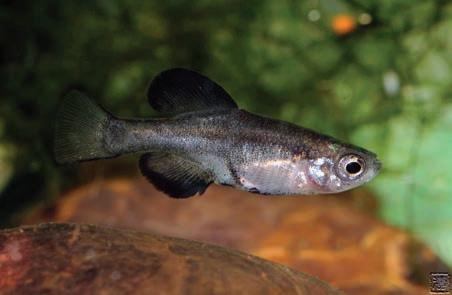

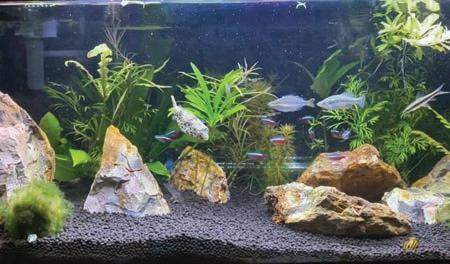




Below are photo submissions to our “Fishy Friends” Facebook group. I’ve left the subjects unnamed, but not the photographer. If you see a shot you like, and want more info, ask the photographer about it! I’m sure he or she will be delighted to tell you!

Modern Aquarium - Greater City A.S (NY)14 October 2022
Geri Domingo
Michael Vulis Frank Pirraglia
Ron Webb
Jules Birnbaum
Wallace DaoV. Huang
The Origin of the Greater City Aquarium Society
by Joseph Ferdenzi
As the unofficial historian of this society, I’ve always wondered about what led to its formation. In my History of the Greater City Aquarium Society (Modern Aquarium, November 2012), I speculated that it had something to do with the demise of the Ridgewood Aquarium Society. Well, a recent event has led me to conclude that my speculation was partially correct: it did have something to do with the Ridgewood Aquarium Society, but not for the reason I believed. What was this recent event?
It starts with a man by the name of Neal Teitler. That name may not be familiar to many of you, but Neal was a member of Greater City in the 1960s. During that time he authored Know Your Goldfish for the Pet Library series, which after being published by Tropical Fish Hobbyist Publications, was reprinted under the title, The ABCs of Goldfish. Also during that period Neal became friends with many of the luminaries of the aquarium hobby—William T. Innes and Herbert R. Axelrod, to name two. But Neal also developed friendships with professional “fish people,” such as James Atz and George Myers.
Neal had been out of the US for a long time—he spent 40 years working on various projects in Japan. He only returned within the past five years, and has been living in California. Recently, some family business required his return to the New York City area where he was born and raised. This in turn led him to contact Greater City via our Web site. One thing led to another, and before long Neal had sent me some wonderful archival material, related to the Ridgwood A.S., as well as our own society. I was also pleased to have him as a guest at my home on a pleasant Sunday, where he regaled me with one fascinating story after another. One of those recollections is the subject of this article.
Neal has always had an abiding interest in the history of our hobby, and so it was that one day he was having a conversation with the already-mentioned George Myers, or more properly, Dr. George S. Myers. Dr. Myers may not be well-known to many of you today, but he was one of America’s most famous ichthyologists of the 20th century. His accomplishments are far too numerous to list here, but suffice it to note that, in addition to being a distinguished professor at Stanford University for decades, he described numerous new fishes that are now staples of our hobby—the most prominent being the neon tetra—and was a prolific writer and editor for many landmark hobby publications (such as all the major Innes ones in the 1930s). But long before he became this worldfamous ichthyologist, he was a boy growing up in northern New Jersey who was very much fascinated by aquariums, and he participated in the local hobby scene for all of his life. Doctor Myers passed away in 1985 at the age of 80.

I have given you this very summary background about Dr. Myers and Neal so that you will have some context for the story that is about to unfold. Given Neal’s membership in Greater City, it was only natural that one day (decades ago) Neal would broach the subject of Greater City’s origin with the very knowledgeable Dr. Myers. And indeed, Dr. Myers was personally familiar with what had occurred. What Neal learned is now presented for the first time in writing.
At the beginning of the 20th century, there were many German immigrants in New York City, and many of them settled in a neighborhood in the southern part of Queens County known as Ridgewood. Quite a few of these immigrants brought with them their love of the aquarium hobby, and subsequently
Modern Aquarium - Greater City A.S (NY) October 2022 15Modern Aquarium - Greater City A.S (NY) August 2017 5
Neal Teitler (left) with the author
This article originally appeared in the August 2017 issue of Modern Aquarium . MA Classics
formed the Ridgewood Aquarium Society. In the 1920s this was a very active society—it held shows, and briefly published a top-flight magazine. Despite the presence of English-speaking members, most of the membership of Ridgewood predominantly spoke German. As a consequence, many of the speakers invited to make presentations at the monthly meetings did so in German. This, quite naturally, eventually led to a rift between the German-speaking members and those who did not speak that language.
It was largely as a consequence of this division that some of the Ridgewood members decided to form a new aquarium society where English would be the dominant language. These break-away hobbyists decided to call it the Greater City Aquarium Society, in tribute to what they hoped would be its inclusiveness of hobbyists from throughout New York City. And so there you have it: the reason behind the origin of our club.
Not coincidentally, when Greater City was formed it had its meetings in Brooklyn, though very close to the border with Queens (for example, the Highland Park YMCA), which was not far from the Ridgewood neighborhood. Of course as we all know,
Greater City went on to great accomplishments, and has been in continuous existence since 1922.
The Ridgewood Aquarium Society survived into the 1930s, but as the influx of German immigrants declined, so did the need for an aquarium society catering to those who spoke only German. Its membership finally dwindled to the point of nonexistence, and the Ridgewood A.S. faded into the mists of history. This narrative is also something I learned from Neal based on his conversations with Dr. Myers.
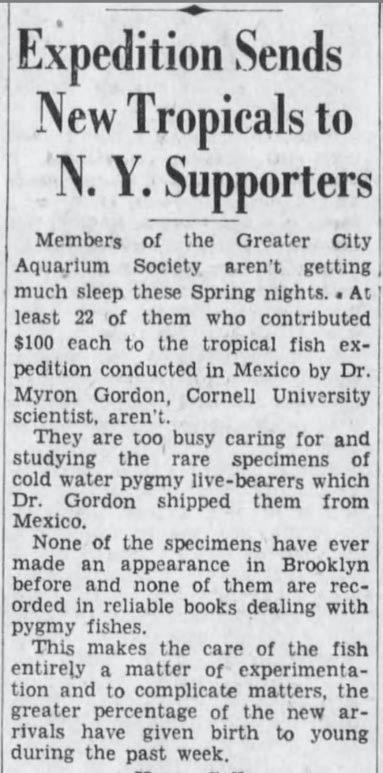
To accompany this article I have copied two items that illustrate some of what I have recounted. One illustration (see facing page) is a list of the members of the Ridgewood A.S. from their 1924 show journal. Examining that list will reveal the predominance of German surnames. The other illustration (below) shows a 1932 article from the now-defunct newspaper, the Brooklyn Daily Eagle, which reports on the results of an expedition to Mexico by Dr. Myron Gordon that was supported by funds from the Greater City Aquarium Society—a testament to the fact that our society has always been at the forefront of our hobby, and worked together with the prominent ichthyologists of the day, such as Drs. Gordon and Myers.
Modern

Modern Aquarium - Greater City A.S (NY)16 October 2022
Aquarium - Greater City A.S (NY)6 August 2017


Modern Aquarium - Greater City A.S (NY) October 2022 17Modern Aquarium - Greater City A.S (NY) August 2017 7 Member list from a 1924 show journal
Tails From the Tank Name That Fish!
by Dan McKercher
of background is required here. I put some black corys into an auction and labeled them as black Venezuelan corys. I thought nothing of it when I acquired the parents with that name. I also noticed that the name is widely used for these critters all over the industry. It is widely thought that they are a color variant of C. schultzei or of C. aeneus. I was approached and told that someone took issue with the name I put on the bags. I explained that this is a common name for these little fellas and nothing more. Then the auctioneer announced that they are NOT as they are marked. He stated that Venezuela does not have black corys within its borders, and they are just black cory schultzei. I saw no reason to challenge his statement. After all, he was partly correct; as of right now nobody has discovered black corys in Venezuela that I know of. The part he got wrong was the name. They are widely known as Venezuelan Black, Black schultzei, or Black aeneus
Abit
So with that out of the way, I thought about how many other fishes fall into what most purists in the hobby would consider as incorrectly named. I am not talking about hybrids here, as that can turn out to be a very interesting or even heated topic of discussion.
One that comes to mind is the Moscow black guppy. Are they indigenous to Moscow? Nope. The guppy is reported to come from South America for the most part. Many have taken pleasure in creating their own line of guppy and naming them as they see fit. Nothing to see here folks, other than that we get to see some real cool looking guppies with some interesting names.
How about Endler’s livebearers? They got their name from a fella by the name of John Endler. Get this―he RE-discovered them and poof! Endlers Livebearers! Their first discovery was by Franklyn F Bind in 1937. Both times they were discovered in Venezuela. Gotta wonder why they weren’t named Venezuelan Livebearers! LOL! Some would
consider them to simply be a landlocked variant of the guppy. They do interbreed with guppies, so judge for yourselves, folks.

Now for, as some call it, the Red Iranian Rainbowfish. If you think, as I did, that these fish are from Iran you would be wrong. The Red Rainbow is found only in Lake Sentani and its tributary streams in the northeastern region of West Papua, New Guinea, near the city of Jayapura. Other common names are Salmon Red Rainbowfish, Red Irian Rainbowfish, and New Guinea Red Rainbowfish. The Cuban Cichlid? Depends on whom you talk/read/listen to. Different folks claim them to be from Central America or Cuba, but specimens have also been collected in Barbados, Haiti and the Dominican Republic. So where did they come from? Guess you had to be there.
I was able to find the above rather quickly on the internet. It solidified my thought that a name is just a name, and does not necessarily tell tell you anything about the person/fish/object. For instance, I have met folks and assumed just by hearing their last name where in the world they or their parents had come from. Sometimes I was correct, but other times I was way off base.
Another interesting subject in this hobby is common fish names. A peacock is a type of bird, but also a fish. Molly is a woman's name, but also a fish, AND a drug! Zebra is a horse type animal, but also many types of fish. This rabbit hole is wide and deep!

In closing, the lesson here is: do not pre-judge something by its name before doing a bit of research. I know from personal experience that it is no fun putting one’s foot in one’s mouth!
P.S. Just in case you were wondering, I am only partly Scottish.
Modern Aquarium - Greater City A.S (NY)18 October 2022
☺ https://www.amazonasmagazine.com/ We thank Amaazonas Magazine for their generous support of our 100th anniversary!
This article originally appeared in the May 1997 issue of Modern Aquarium .

Modern Aquarium - Greater City A.S (NY) October 2022 19
MA Classics

Modern Aquarium - Greater City A.S (NY)20 October 2022

Modern Aquarium - Greater City A.S (NY) October 2022 21

Modern Aquarium - Greater City A.S (NY)22 October 2022
May Bowl Show Winners:
1 tony Siano
2 Richie Waizman
June Bowl Show Winners:
1 Richie Waizman
Frontosa
2 Tony Siano Angelfish

3 Mario Bengcion Betta
July Bowl Show Winners:

1 Richie Waizman
half-moon plakat
2 Richie Waizman Blue & Red half-moon
September Bowl Show Winners:
1 John “Buzz” Buzzetti
Aphyosemion Australe
2 John “Buzz” Buzzetti Fundulo panchax
3 Roger inseti Bicolor Betta
Modern Aquarium - Greater City A.S (NY) October 2022 23
GCAS Member Discounts
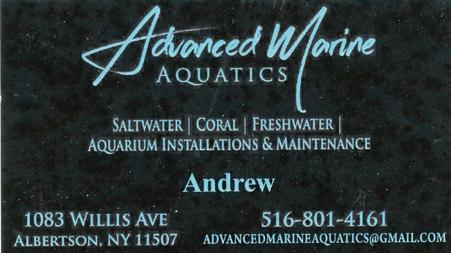







Modern Aquarium - Greater City A.S (NY)24 October 2022 10% Discount on everything except ʽon saleʼ items. 20% Discount on fish. 15% on all else. 10% Discount on everything. 10% Discount on everything. 10% Discount on everything. 10% Discount on fish. 10% Discount on everything.
at Local Fish Shops 10% Discount on everything.







Modern Aquarium - Greater City A.S (NY) October 2022 25 10% Discount on everything. 10% Discount on everything. 15% Discount on everything in store, or online at: http://www.junglebobaquatics.com Use coupon code gcas15. 10% Discount on everything. We thank ZooMed for their generous support of our 100th anniversary!
Modern Aquarium Covers
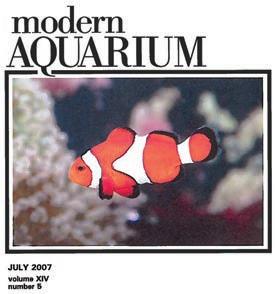


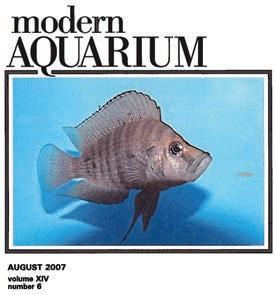


March 2007 Betta macrostoma by Alexander A. Priest
April 2007 Herichthys carpintis by Dan Radebaugh
May 2007 Tanichthys albonubes by Alexander A. Priest
June 2007 Acarichthys heckelii by Brad Dickinson
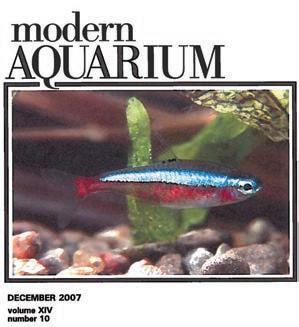

July 2007 Clownfish by Alexander A. Priest
August 2007 Altolamprologus species by Alexander A. Priest
September 2007 Malpulutta kretseri by Alexander A. Priest
October 2007 Anubius Species by Alexander A. Priest
November 2007 Mikrogeophagus ramirezi by Frank Fallon


December 2007 Paracheirodon axelrodi by Alexander A. Priest

Modern Aquarium - Greater City A.S (NY)26 October 2022
2007
In spite of popular demand to the contrary, this humor and information column continues. As usual, it does NOT necessarily represent the opinions of the Editor, or of the Greater City Aquarium Society.

A series by the Undergravel Reporter

Asaquarists, I’m sure you’ve at least heard of the croaking gourami (Trichopsis vittata ). They got their common name because they are capable of producing a “croaking” sound by using their pectoral fins. Sparkling gouramis are also known to make a “croaking” sound when they are mating or happy. This sound comes from modified pectoral-fin tendons and muscles. Once these tendons and muscles are stretched, they can be used to make a croaking sound.
So far, about 1,000 fish species have been recorded making sounds. You can listen to some of them at a website called FishSounds. Unlike birds, which make sounds in the same way, fish evolved to make sounds many times during their existence. That means they make sounds in different ways.

Fish don't have specialized vocal cords, larynxes or vocal folds. So one of the most common ways they make sound is through tribulation — rubbing two pieces of bony structure together, like clicking their teeth or rubbing their pectoral fins against other structures to make cricket(-like) sounds. Many others make sound with their swim bladders, which they use primarily to stay buoyant and level in the water. Some fish have a sonic organ of some kind attached to this swim bladder, so they can (bang) on it and it resonates like a drum.
Some scientists estimate as many as 22,000 of the 34,000 known fish species produce sounds. And those are just the sounds fish make on purpose — to call to mates, to let other fish know they're in trouble or to communicate that “this is my area of the reef, listen to how tough I sound so why don't you just swim away?”
Active and passive sounds are important because they convey a lot of information about what's going on. Chewing sounds, for example, let anyone who is listening know that there’s a food source available. And the mating and warning noises of certain fish species tell scientists information such as how much diversity is on a reef, where invasive species are located, and where endangered species are located.
Modern Aquarium - Greater City A.S (NY) October 2022 27
References: https://fishsounds.net/index.js https://www.thegazette.com/kids-articles/in-lakes-and-ponds-fish-are-growling-grunti ng-and-humming/ Modern Aquarium - Greater City A.S. (NY) October 2022 17
Fin Fun
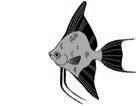

Can you navigate the waves in the maze below?


Solution to our last puzzle:


Modern Aquarium - Greater City A.S (NY)28 October 2022
24 October 2022 Modern Aquarium - Greater City A.S. (NY)


100th Anniversary! 1922-2022





















































































